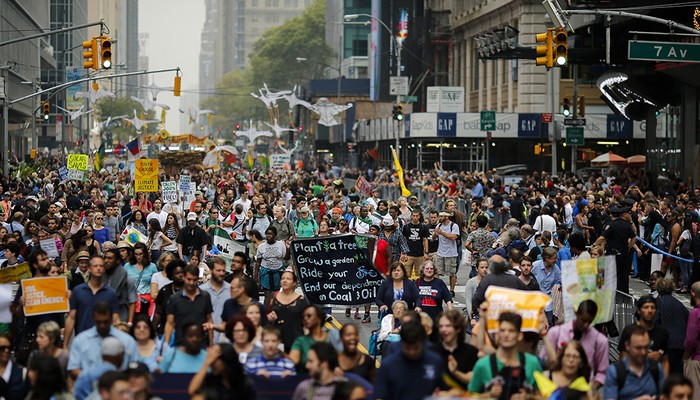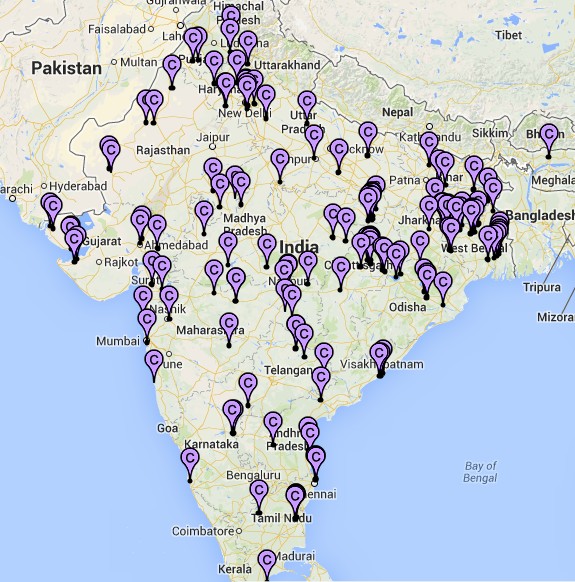
A part of the people’s march against climate change in New York, USA. Photo: Reuters / Eduardo Munoz
The United Nations Climate Summit 2014, held on 23 September, can be considered as a study in two contrasts. On the one hand was the People’s Climate March – an enormous gathering of concerned citizens in New York, USA, which may have seen a combined total of some 400,000 people. The marchers through their diversity and energy delivered one message in many creative ways. That message was: we citizens can and will rid the planet of fossil fuels and nuclear power, that such action will be demanding and difficult but we will do it at the grassroots and make a difference there.
On the other hand was the Climate Summit. This, said the UN, would serve as a public platform for leaders at the highest level, by which is meant all UN Member States, as well as finance, business, civil society and local leaders from public and private sectors. The gathering, said the UN, would “catalyse ambitious action on the ground to reduce emissions and strengthen climate resilience and mobilise political will for an ambitious global agreement by 2015 that limits the world to a less than 2-degree Celsius rise in global temperature”.
Did it succeed? No and yes. If there has been a gain from the events of 23 September it is to strengthen their individual and community resolve to act locally in an effort to tackle both the effects and the causes of climate change.
Where the Summit itself is concerned, against the background of 22 years of negotiations and conferences on climate change (the UN Framework Convention on Climate Change came about in 1992) it proved to be atypical. There were a number of promises and resolutions made to add to the mountain of such promises and resolutions but this summit – like every single other summit before it – brought no significant response from the political establishment.
Unsurprisingly, this is not how the UN sees the outcome of its recent work, for UN Secretary-General Ban Ki-moon summed up the Summit as “a great day, a historic day. Never before have so many leaders gathered to commit to action on climate change”. Ban said that the Summit he called “delivered” because the many leaders attending “reaffirmed determination to limit global temperature rise to less than 2 degrees Celsius by cutting emissions”.
Such announcements underline the contrast between the desire on the street and the cold comfort of summit announcements (now in their 22nd year). On 23 September the UN tip-toed around the large global and regional corporations (and their financier special interests) whose business practices have deepened environmental and socio-economic emergencies all over the world, and which are responsible for worsening – much less alleviating – the vulnerabilities of populations exposed to the risk of climate change.
The UN has regrettably turned into a recurring practice this avoiding of issues central to climate change (see the summary document, pdf, 243kb). But, at the same time, the UN together with a host of organisations that have more or less to do with climate change (private, academic, industry fora and so on) repeated once more a worn roster of promises.
These are:
* “Strong support” for the Green Climate Fund, with one more total being pledged (precious little has been actually transferred) and still more being “committed” (these are all commitments with renewable expiry dates).
* “A new coalition of governments, business, finance, multilateral development banks and civil society leaders” (what happened to all the other coalitions announced grandly at every other summit?) which once again was quick to commit to providing US$ 200 billion “for financing low-carbon and climate-resilient development”, including banks which want a ‘Green Bonds’ market.
* That carbon pricing continues to be “one of the most powerful tools available for reducing emissions and generating sustainable development and growth”, which in the end is a promise to continue the commodification and financialisation of emissions, an extremely troublesome industry whose regulation has proved difficult.
Instead of such expensive jamborees whose recycled announcements do little more than provide a false sense of security to citizens, the UN should emulate the example of the marchers and encourage small, local and meaningful action.
After the sound-and-light show of the Climate Summit 2014 we advocate just as strongly as before that it is local development – of, by, and for the people – which finds and leverages appropriate technology, encourages open source collaboration, and focuses on pragmatic, technical solutions to our problems, that will make the difference. Such action alone will reduce our impact on the environment and hedge households and communities against natural disasters made worse by a ritual of inaction.




 We must question the profligacy that the Goyal team is advancing in the name of round the clock, reliable and affordable electricity to all. To do so is akin to electoral promises that are populist in nature – and which appeal to the desire in rural and urban residents alike for better living conditions – and which are entirely blind to the environmental, health, financial and behavioural aspects attached to going ahead with such actions. In less than a fortnight, prime minister Narendra Modi (accompanied by a few others)
We must question the profligacy that the Goyal team is advancing in the name of round the clock, reliable and affordable electricity to all. To do so is akin to electoral promises that are populist in nature – and which appeal to the desire in rural and urban residents alike for better living conditions – and which are entirely blind to the environmental, health, financial and behavioural aspects attached to going ahead with such actions. In less than a fortnight, prime minister Narendra Modi (accompanied by a few others) 


